San Beda University
San Beda University (Filipino: Pamantasang San Beda, Spanish: Universidad de San Beda) is a private Roman Catholic university run by the Benedictine monks in the Philippines. Its main campus which provides tertiary education is situated in Mendiola, Manila. It has an affiliated campus that provides elementary and high school education in Taytay, Rizal.[1] The Benedictine College in Alabang, Muntinlupa known as the San Beda College Alabang is an autonomous institution despite being an affiliate of San Beda University.
Pamantasang San Beda | |
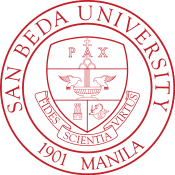 Official Seal | |
| Latin: Universitas Sancti Bedæ | |
Former names | El Colegio de San Beda (1901–1918) San Beda College (1918–2018) |
|---|---|
| Motto | Fides, Scientia, Virtus (Latin) |
Motto in English | Faith, Knowledge, Virtue |
| Type | Private Roman Catholic Research Non-profit Coeducational Basic and Higher education institution |
| Established | June 17, 1901 (119 years and 59 days) |
| Founder | Fr. Juan Sabater, OSB |
Religious affiliation | Roman Catholic (Benedictine) |
Academic affiliation | Mendiola Schools Consortium, PAASCU, FAAP, ASAIHL, AUAP, ASEACCU, BENET, ICBE, CEAP, CBCMMI, SALT, ALNC |
| Chairman | Manuel Vélez Pangilinan, MBA, D.H.L. (Hons. Causa) |
| Chancellor | Rt. Rev. Abbot Austin P. Cádiz, OSB |
| Rector | Rev. Fr. Aloysius Ma. A. Maranan, OSB |
| University Executive Officer | Assoc. Prof. Jobe B. Viernes, D.D.A. |
| Students | 9,200 (2019) |
| Location | 638 Mendiola, San Miguel, Manila , , Philippines 14.599465°N 120.992336°E |
| Campus |
|
| Alma Mater Song | Bedan Hymn |
| Colors | Red |
| Athletics | Varsity team names: Red Lions (college men's varsity teams) Red Lionesses (college women's varsity teams) Red Cubs (High School boys' varsity teams) |
| Nickname | Bedans |
Sporting affiliations | NCAA, NCC |
| Sports | Varsity sports teams: Basketball Volleyball Beach Volleyball Football Badminton Chess Taekwondo Table Tennis Lawn Tennis Soft Tennis Swimming Track & Field |
| Mascot | Red Lion |
| Website | sanbeda.edu.ph |
San Beda was established in 1901 by monks of the Ordo Sancti Benedicti (OSB) or Order of St. Benedict, also known as the Benedictines. Its founder, St. Benedict, is acclaimed as the "Father of Western Monasticism" and the "Patron of Europe". From its inception, the school was dedicated to the cause of Catholic education and the formation of Christians committed to excellence and service of God and country. It is attached to the Abbey of Our Lady of Montserrat, founded from the Abbey of Montserrat in Cataluña, Spain.
San Beda, which was known as El Colegio de San Beda, started as an all-boys grade school in Manila. It has since expanded to a full university with both undergraduate and post-graduate degree programs. The institution has been a recognized university since February 6, 2018, marking it as a Benedictine University found only in the Asia-Pacific region.
History
Origin
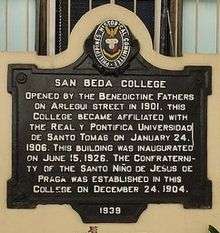
In 1895, 14 Benedictine monks from the Abbey of Our Lady of Montserrat in Spain arrived in the Philippines. Their intent was to do mission work in Surigao. However, as Americans slowly but successfully began to colonize the Islands, the Benedictine monks, fearing the spread of Protestantism, began to contemplate the idea of establishing a school dedicated to propagate and defend the Catholic faith. This vision was realized in 1901 when the monks transferred to Manila and Spanish Benedictine monk Fr. Juan Sabater OSB founded the El Colegio de San Beda, so named after the Venerable St. Bede of England. It was located in Arlegui Street.
During the inauguration of San Beda on June 17, 1901, Fr. Silvestre Jofre, OSB said in his homily that, “The College of San Beda comes to the arena with the sole purpose of helping to defend the Catholic battlements in the field of education.” The school opened exclusively for young boys with 212 students taking primaria enseñanza and secundaria enseñanza, the equivalent of grade school and high school with the first two years of college.[1]
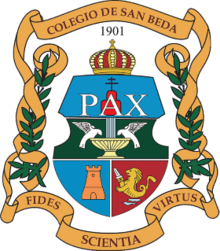
On 24 January 1906, San Beda College became affiliated with University of Santo Tomas. Bedan graduates were allowed to pursue further studies at UST without having to take qualifying exams. In 1910, however, the school revised its whole academic curriculum as a result of the requirements set by a new law in order for schools to be recognized by the government. San Beda became an independent private college with the authority to grant the Bachelor of Arts degree and diplomas in elementary and high school. It began to shift from Spanish to English as language of instruction and started to teach not only the English language but American history and politics as well. In 1916, Jesus Y. Mercado, a member of the Benedictine order, designed the first college seal.[2] In 1918, as a result of the growing American influence, the college decided to drop its old name, El Colegio de San Beda, and began calling itself San Beda College.[1]
In 1926, the Benedictine monks moved the school to Mendiola Street where it still stands. The transfer was needed to cope with demands for a bigger campus. By 1927, the courses offered by San Beda expanded and included grade school, high school, two-year courses of pre-medicine and pre-law, and the first two years of commerce. During that year, Bedan athletes won their first crown in the National Collegiate Athletics Association (NCAA) league.
From 1940 to 1947, the Abbey of Our Lady of Montserrat in Manila was under the apostolic administration of Abbot Alcuin Deutsch, OSB of St. John's Abbey, Collegeville, Minnesota. Three monks were sent to Manila to administer the Abbey and San Beda College. The College welcomed the only American rector in its history, Fr. Boniface Joseph Axtmann, OSB. In 1940 the school began to carry the Red Lion as its emblem. When World War II broke out, San Beda College was used by the Japanese Imperial Army as a garrison and supply depot. During these years, classes were held quietly in the Abbey of Our Lady of Montserrat, although classes were limited.
After the liberation by joint Filipino and American troops, San Beda was used by the 60th U.S. Army Field Hospital briefly.[1]
After the war, the school began to expand. After the priest Boniface Axtmann's liberal democratic style of running the College ended in 1947, a similar kind of leadership emerged under the administration of the Spanish Benedictine priest, Sergio Martinez, OSB. During his term, he decided to offer programs in arts, sciences, and jurisprudence. In 1948, Martinez formally established the San Beda College of Law. From 1952 to 1957, and 1960 to 1961, the San Beda Law School earned the distinction of producing a 100% passing record during the bar examinations. San Beda College became one of the founding schools of the Catholic Educational Association of the Philippines.
Eventually, San Beda College became a chartered school of the Philippine Accrediting Association of Schools, Colleges and Universities in 1957. Then Rector Fr. Benigno Benabarre, OSB was responsible for the school's inclusion in the PAASCU. He set up an alumni network of Bedans, which would eventually become the San Beda College Alumni Association.[1]
On June 17, 2001, San Beda College celebrated its centennial. During the opening ceremonies for its pre-centennial in 2000, former president Corazon Aquino, Bedan alumni senators Raul Roco and Rene Saguisag and then rector-president Bernardo Ma. Perez, OSB graced the event.
In that same year, a new administration under Fr. Anscar J. Chupungco, OSB was installed. At the same time, San Beda College offered the Graduate Program in Business which was granted full autonomy and rated "very good" by the Commission on Higher Education.[3]
On June 17, 2002, the San Beda College of Medicine and the Graduate Program in Liturgy were inaugurated, heralding the school's expansion program in health sciences. The following year, the College of Nursing and the Graduate School of Law were established. To give a more conducive academic environment to grade school and high school students, the San Beda College-Rizal campus was formally opened in June 2004. That same year, St. Benedict's College was formally renamed San Beda College Alabang.
San Beda represented the Philippines in a five-country research collaboration in the ASEAN region. On February 10, 2009, Fr. De Jesus, representing San Beda College, signed an agreement with the Presidents of Institut Teknologi Bandung, Indonesia; Universitas Kelantan, Malaysia; Ho Chi Minh Business University, Vietnam; and University of St. Galen, Switzerland (in collaboration with Singapore), establishing the ASEAN Network for Inter-Cultural Management and Economic Studies (ANIMES). The Research Network will provide faculty members of San Beda College an international window for their research outputs as well as joint research activities with peers from the other ASEAN countries.
On February 6, 2018, San Beda was granted University status by the Commission on Higher Education 501st Commission-en-Banc and Management Committee.
Campuses
San Beda University Manila
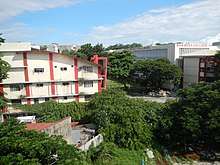
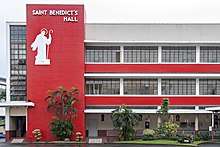
Although the Mendiola campus is the oldest, the first San Beda campus was originally in Arlegui Street near the compounds of the Malacañang Palace. The Benedictine College, however, decided to relocate the school and the order's monastery to Mendiola to accommodate an increasing student population. The Mendiola Campus formally opened in 1926.
Due to the social and political unrest during the 1970s, the Benedictine monks initially entertained the thought of leaving Mendiola and of transferring to Alabang where they recently acquired a property. The monastic fathers abandoned the idea and decided to stay in Mendiola and to build another campus in Alabang at the same time.
SBU Manila houses four colleges: Arts and Sciences, Nursing, Medicine, and Law. The three graduate schools of San Beda – Business, Law, and Liturgy – are in the Mendiola campus. The campus also houses the Senior High School Department of SBU Manila.
College of Arts and Sciences
The College of Arts and Sciences is the oldest college or tertiary level department in San Beda University. It was founded in the year 1910, making it the second oldest liberal arts college in the Philippine Isles. More fondly called by its acronym, "CAS," the Arts and Sciences department has brought many awards and achievements to San Beda University. The CAS was instrumental in San Beda University's being granted the Level III accreditation and reaccreditation in 2001, in 2003, and in 2014 respectively, by the PAASCU, as well as the autonomy status given by the Commission on Higher Education in 2003.
College of Nursing
The San Beda College of Nursing (CON) offers a Bachelor of Science in Nursing program. The CON began its operations 2003, in consortium with the Loyola Medical College Foundation chaired by Dr. Johnny Fong. The consortium with Loyola Foundation ended in 2008. The CON is now solely run by San Beda. The Nursing School of San Beda has been granted PAASCU Level I Accreditation.
College of Medicine
In addition to the Nursing department, the San Beda University administration put up another department to strengthen its health sciences program. The San Beda College of Medicine (SBCM) was formally established on March 9, 2002, with the task of offering a four-year course leading to the degree of Doctor of Medicine (M.D.)[3] as its fifth unit. It has a faculty of over 70 medical lecturers, who come mostly from the University of the Philippines Manila.
The college is at St. Benedict's Hall. It uses several laboratories in St. Maur's Building along with other colleges and has a dedicated cadaver room on the third floor for its anatomy classes.
The CoM has sent examinees from its first class of graduates from the school term 2002–2003 to the August 2007 medical board exams.[4]
College of Law
The San Beda College of Law (CoL) was founded in 1948 upon the initiative of former rector-president Fr. Sergio Martinez, OSB. Feliciano Jover Ledesma, an Ateneo graduate, was the first dean of the San Beda Law School. It sent bar candidates for the first time in 1952, who all passed the bar. From 1952 up to 1957, and 1960 to 1961, the San Beda Law School achieved the feat of attaining a 100 percent passing rate in the Bar Exams.[5]
It has produced lawyers such as the current President of the Philippines Rodrigo Duterte, former Senator Rene Saguisag, the late Senator Raul S. Roco, Senator Leila M. De Lima, Former Commission on Elections Chairman Sixto Brillantes Jr., and nine Justices of the Supreme Court – Florenz D. Regalado, the holder of the highest bar exam grade in the country, Justo P. Torres Jr., Antonio M. Martinez, Romeo J. Callejo Sr., Antonio Eduardo Nachura, Jose Catral Mendoza, Bienvenido Reyes, Samuel Martires, and Noel Tijam.
Graduate Schools
- Graduate School of Business
- Graduate School of Law
- Graduate School of Liturgy
San Beda University Integrated Basic Education Department

The Affiliated Rizal Campus of San Beda University is also known as the San Beda University Integrated Basic Education Department. It is in Havila Main Road, Barangay San Juan, Taytay, Rizal and became operational in academic year 2004–2005, initially with nursery, Kinder, preparatory, grade 1, and first and second year high school levels. Thus, the primary, middle, and high schools became the units of the Integrated Basic Education Department (IBED). Moreover, the academic curriculum was re-aligned with the school's co-educational program and the phase-out of the grade and high school departments in the Manila campus. The last batch of Grade 6 students in Manila campus graduated in 2009 and 4th Year High School in 2006.[6]
The Affiliated Integrated Basic Education Department is composed of the following: Grade School, Junior High School, and Senior High School.
San Beda College Alabang
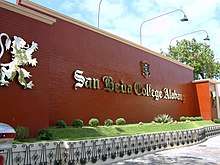
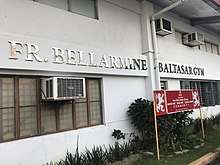
Located in Alabang Hills Village in Muntinlupa, San Beda College Alabang (SBCA) was founded on July 10, 1972, and was originally named the Benedictine Abbey School. It began as a basic co-educational school. In 1995, it gained college status and renamed itself as St. Benedict College which also marked the opening of the Fr. Bellarmine Baltasar Gymnasium (then St. Benedict College Gym). In 2001, Fr. Aloysius Maranan established the College of Arts and Sciences program to its college curriculum. In 2004, the college changed its name and has formally adopted the name, San Beda College Alabang.[7]
The rector-president of San Beda College Alabang is Dom Clement Ma. H. Roque, OSB, who served as former dean of the College of Arts and Sciences in San Beda University, Manila.
Administration
The following are list of people who have served as rector presidents of San Beda University. All have were monastics who are affiliated with the Order of Saint Benedict.
| RECTOR-PRESIDENTS | ||
|---|---|---|
| SAN BEDA COLLEGE | ||
|
1901–03 – Silvestre Jofre |
1939–41 – Wilfrido Rojo |
1967–68 – Hildebrando Muñoz |
| SAN BEDA UNIVERSITY | ||
| 2018–22 - Aloysius Ma. A. Maranan | ||
Publications and journals
Academic and research journals
San Beda University has published research materials and scholarly journals published by its faculty and administrators.
The College of Arts and Sciences publishes an annual scholarly journal called Scientia, which deals with topics such as economics, social sciences, history, public administration and management concepts. The College of Law releases an annual research material called The San Beda Law Journal. The articles in the San Beda Law Journal are written by the students and faculty of the San Beda Law School. The Graduate School of Business faculty articles are published in the Graduate School of Business Journal. The Graduate School of Liturgy produces the Scientia Liturgica, a journal that is dedicated to the advancement of liturgical studies in the Philippines and in Asia. The Graduate School of Law publishes the well-respected San Beda Graduate School of Law Journal of Graduate Research.
The College of Nursing and Medicine publishes the Journal of Health and Caring Sciences which publishes emerging topics on human health, wellness and caring science.
Architecture
Since its construction in Mendiola Street, majority of the buildings of San Beda University adapted the Neo-Gothic style of architecture.[8] However, renovations have been made in some areas such as the tiles and gates. New structures were constructed such as the covered walk and pavilion near the entrance gate.
School traditions
San Beda University adopted the Red Lion emblem from the ancient Scottish/English heraldic symbol, the Red Lion Rampant.[9][10] The school, named after the Venerable Bede of England, naturally chose the heraldic symbol of the ancient Scots/English for courage.[11] It has been said that the Judeo-Christian roots of the Anglo-Saxon world was preserved by the Benedictines during the Dark Ages through faith and courage.[12] Pope Benedict XVI himself openly declared that the Benedictines saved Europe's Christian roots.[13] San Beda pays tribute to the courage of the Benedictine monks by adopting the Red Lion, the symbol of courage in the Catholic tradition and in the land of St. Bede.[14] It has to be noted that the Benedictines are a key part of the history of Great Britain itself.[15][16][17]
The Bedan hymn
Before the beginning of the 1960s, Bedans were singing a different school hymn. In 1966, Senator Raul Roco, then a San Beda Magna Cum Laude law student; Arturo Montesa, wrote a new alma mater hymn which would capture the Bedan spirit. After finishing the lyrics, Roco then gave the lyrics to Rev. Fr. Benildus Ma (Manuel) Maramba, OSB for its melody, arrangements, and orchestration. It took Fr. Maramba two days to finish the song composition.[18]
It is sung at important events such as the NCAA basketball season, the Bar exams, alumni gatherings, and at simple affairs such as seminars and small get-together of Bedans.
Red Lion and The Ancient Red Lion Rampant
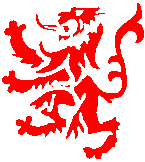
The practice of adopting a school moniker became both fashionable and an imperative especially for Catholic school named after Saints during the 1940s in the Philippines.[10][19] The American Catholic schools started the rage earlier when the clergy became wary of sports headlines such as “ St. Peter mauls St. Paul 80 – 40”. In the Philippines, headlines of whipping and trashing of schools named after saints drew mixed emotions among the clergy and devout Catholics. “Why would a Catholic saint whip another Catholic saint?”, they would ask.
On July 31, 1940, Fr. Sergio Martinez OSB, inspired by English tradition, coined the moniker “Red Lion” for the school.[20] Red is the color of courage, of a warrior and a martyr. The lion, on the other hand, represents dominance as the king of the jungle.[9][10][21]
Indian Yell
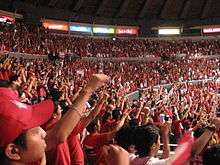
The Cuerba brothers, both Bedans, composed the Indian Yell in 1947 after the liberation from the Japanese empire.[10][20][22] The Indian Yell was initially solely performed on drums accompanied by cheers from the students. However, this made the cheer somewhat lacking in power and needed something to rejuvenate the audience. So they changed the sound of the yell and incorporated a horn section. Accompanied by the tomahawk chop, the Indian Yell became more lively, intimidating, and full of spirit.[9][20]
The Indian Yell is San Beda's romanticized version of the Indian war whoop. It mimics the native Indian war chants and vocalization techniques designed to intimidate the opponent.[22] North American Indian war chants are verbalization of tunes that implore the great spirits to help them in battle. The romanticized Bedan Indian Yell is believed to have been inspired by the Plains Indian.[9]
The Indian war whoop gave rise to derivative chants, most especially the Lion's Roar. The Lion's roar, with the simple "Wooohooo", mimics chants of Native American Indians. This is an indirect offspring of the Wahoos started by Dartmouth College and the University of Virginia in the 1890s.[23] Bedans popularized this aboriginal Native American form of chanting in the Philippine collegiate league and has spawned variations now used by many other schools.[9][10][22]
Little Indians
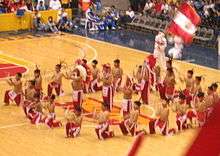
To accompany the Indian Yell, the Little Indians were conceptualized by Ramon Ventoza (GS '46, HS '51).[9][10][22] Mon Ventosa is the longest serving moderator / instructor of the San Beda College Cheering Association. A cheerleader during his student days in San Beda College, Mon was appointed as instructor of the college's Cheering Squad (1952–1962). He came up with idea to counter the gaining popularity of the dance number of Jose Rizal College.[20]
There were only three Indians in 1947: Gabriel Gasar and the Casal brothers (one of whom eventually became a Benedictine monk). Slowly, the recruitment process changed and participation from the grade school pupils rose because many wanted to become Little Indians. Tito Mon wanted the Indians to be stout and adorable. From three Indians since 1947, the membership rose to a minimum of eight in the 90s.[10][20]
`¡Ánimo San Beda!
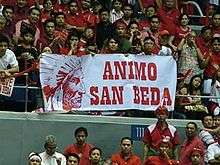
One of the more popular line in the traditional Bedan cheers is "¡Ánimo San Beda!".[24]
Bedans use Ánimo to mean courage in their cheers. When Bedans yell “¡Ánimo San Beda!” they actually mean “Courage San Beda!/Have Courage San Beda!" — faithful to the Spanish idiomatic usage of the word.[9][25][26] Animo is a Spanish word which means spirit, energy, vitality, purpose and will. Used as an expression of encouragement by Spanish-speakers, it means courage or have courage. "¡Avance San Beda!" and "¡Vamos!" were popular then. In the pre-war Spanish San Beda cheer (also known as El Colegio de San Beda Tiene que Ganar!), "Ánimo" is included.[24][25]
Notable people
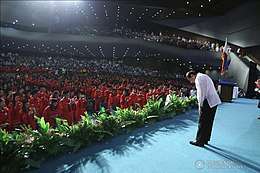
As one of the reputable educational institutions in the Philippines, San Beda University counts among its illustrious roster of students, alumni and graduates numerous national leaders and pioneers in politics, business, law, athletics and entertainment such as the 16th Philippine President Rodrigo Duterte,[27] Senator Leila de Lima,[28] former senator Benigno S. Aquino Jr.,[29] former senator Raul S. Roco, former Speaker Ramon V. Mitra,[29] former senator and human rights icon Rene Saguisag, former Supreme Court Chief Justice Roberto Concepcion, Associate Justice Florenz Regalado,[30] business tycoon Dr. Manuel V. Pangilinan,[31] real estate and property magnate Ambassador Eduardo Antonino B. Antonio, business tycoon, billionaire and entrepreneur Robet Coyiuto, Philippine basketball legend Carlos Loyzaga,[32] actor Eddie Gutierrez, and 2004 Philippine presidential candidate & actor, Fernando Poe, Jr., and people that have been recognized as one of the top 10 students in the Philippines.
References
- San Beda College-History Archived July 1, 2009, at the Wayback Machine
- "100 Years of Benedictine Education San Beda College 1901–2001". San Beda College. Cite journal requires
|journal=(help) - The Rector-President's Report 2001-2007
- The Bedan August 2007 Issue: Medisina umariba sa board exams
- The Bedan Centennial Issue, p.5
- "ABOUT SAN BEDA COLLEGE RIZAL". Retrieved July 16, 2016.
- The Bedan July 2004: St. Bene is now San Beda Alabang
- Axtman, OSB, AB, Boniface (1941). Educational Work of the Benedictine Order in the Philippines. Manila: University of Santo Tomas.CS1 maint: multiple names: authors list (link)
- Jude Roque and the San Beda Boosters Club. A Time To Roar:Reviving the Bedan Animo. Manila: n.p, 2007 Archived August 22, 2007, at the Wayback Machine
- Toloma et al. Abbey Monty. Manila: n.p., 2006
- History of San Beda College Archived November 5, 2006, at the Wayback Machine
- Brown, Martin and O Clabigh, Colman (Editors).The Irish Benedictines: A History. Dublin:Columba Press, 2005 "Archived copy". Archived from the original on February 14, 2011. Retrieved July 6, 2008.CS1 maint: archived copy as title (link)
- Pope Benedict XVI. Christianity and the Crisis of Cultures – The Europe of Benedict. Ignatius Press, 2006 Christianity and the Crisis of Cultures - The Europe of Benedict | The Catholic Company Archived February 14, 2011, at WebCite
- "A Primer To Catholic Symbolism". Boston Catholic Journal. Online. Internet. Accessed May 23, 2007. Archived June 25, 2007, at the Wayback Machine
- "The Benedictines". Britannia. Online. Internet. Accessed 23 May 2007 Archived February 14, 2011, at WebCite
- "A Note on Benedictines". Worth Abbey Official Website. Online. Internet. Accessed May 23, 2007 A Note on Benedictines Archived February 14, 2011, at WebCite
- Dom David Knowles. The Monastic Order in England. Cambridge:Cambridge University Press, 1949 Archived August 31, 2010, at the Wayback Machine
- The Barrister October–November 2005: Raul S. Roco 1941-2005
- Ateneo de Manila Official Website Archived February 14, 2011, at WebCite
- Ramon Jose. "The Lion and The Indian". The Bedan Centennial Issue. 2001
- "The Meanings Behind the Symbols".Fleurdelis Designs. Online. Internet. Accessed May 23, 2007.Fleur-de-lis Designs - Custom Crests, Logos, and Coats of Arms Design Services Archived February 14, 2011, at WebCite
- Saguisag, R. "Manny P and Bedan Nostalgia" .The Manila Times August 9, 2006.The Manila Times | Trusted Since 1898 Archived October 19, 2007, at the Wayback Machine
- Meacham, S. "The Persistence of Wahoowah, Dartmouth's Indian Yell, at the University of Virginia". Online. Internet. Accessed May 23, 2007 http://www.dartmo.com/Indian_Yell_Meacham.pdf
- San Beda Songs and Cheer Book. 1954
- Danny."¡Ánimo San Beda! = Have Courage/Take Courage San Beda!".Online Posting.November 3, 2006. Gameface.ph (General Discussion-Stop Copying Our Cheers and Drumbeats). Accessed May 23, 2007 Archived April 27, 2007, at the Wayback Machine
- Guillermo, K. Animo!. Holy Fire Publishing, 2006 Archived February 14, 2011, at WebCite
- Aurelio, Julie M. "Why Duterte almost missed the bar exams". newsinfo.inquirer.net. Retrieved June 25, 2019.
- "Sen. Leila de Lima elated after son passes Bar exam". Manila Bulletin News. Retrieved June 25, 2019.
- "Why Howard Dee's work is unending". Inquirer Lifestyle. August 25, 2018. Retrieved June 25, 2019.
- Torres-Tupas, Tetch. "SC Associate Justice Florenz Regalado; 87". newsinfo.inquirer.net. Retrieved June 25, 2019.
- "What San Beda's students think about its new university status". Inquirer Lifestyle. February 9, 2018. Retrieved June 25, 2019.
- "Greatest Filipino basketball player of all time, Caloy Loyzaga passes away at 85". GMA News Online. Retrieved June 25, 2019.
External links
| Wikimedia Commons has media related to San Beda University. |
- San Beda University Official Website